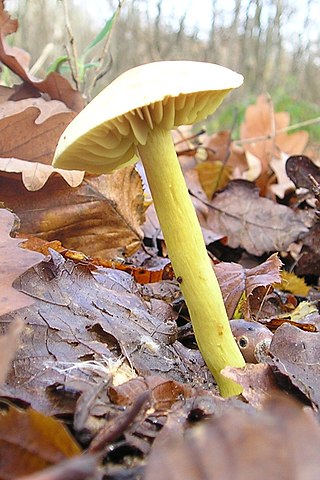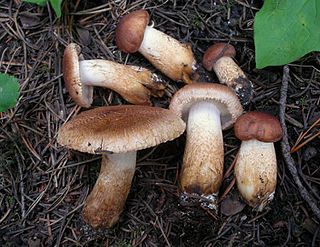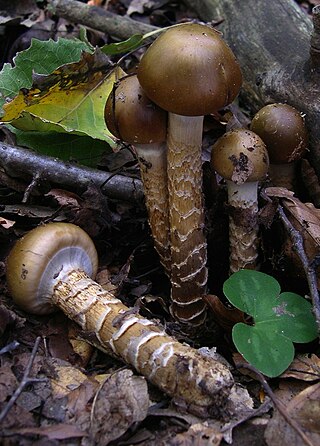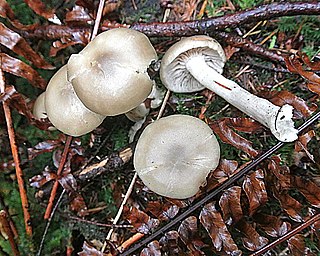
Tricholoma equestre or Tricholoma flavovirens, also known as man on horseback or yellow knight is a formerly widely eaten but arguably hazardous fungus of the genus Tricholoma that forms ectomycorrhiza with pine trees.

Tricholoma sulphureum, also known as sulphur knight or gas agaric, is an inedible or mildly poisonous mushroom found in woodlands in Europe. It has a distinctive bright yellow colour and an unusual smell likened to coal gas. It occurs in deciduous woodlands in Europe from spring to autumn.

Agaricus campestris is a widely eaten gilled mushroom closely related to the cultivated button mushroom Agaricus bisporus. It is commonly known as the field mushroom or, in North America, meadow mushroom.

Clitocybe nebularis or Lepista nebularis, commonly known as the clouded agaric or cloud funnel, is an abundant gilled fungus which appears both in conifer-dominated forests and broad-leaved woodland in Europe and North America. Appearing in Britain from late summer to late autumn, it is edible, but may cause gastrointestinal issues.

Gymnopilus sapineus, commonly known as the scaly rustgill, is a small and widely distributed mushroom which grows in dense clusters on dead conifer wood. It has a rusty orange spore print and a bitter taste. This species does not stain blue and lacks the hallucinogen psilocybin.

Tricholoma ustaloides is a species of mushroom in the large genus Tricholoma. It has a widespread distribution in Europe, where it is typically found in association with oak and beech trees. Although generally considered inedible, it is consumed by some in Mexico.

The inedible wild mushroom Russula fragilis, which goes by the common name of the fragile brittlegill, is a member of the genus Russula, whose members are commonly known as brittlegills. It is a small, fragile, long stemmed, and variably coloured brittlegill, found in mixed forests, and woods in Europe, Asia, and North America.

Agaricus placomyces is a toxic basidiomycete fungus of the genus Agaricus. It is found in North America; the Eurasian populations formerly known by the same scientific name are nowadays known as A. moelleri, while the present species may also be referred to as A. praeclaresquamosus.

Gymnopilus bellulus is a species of mushroom in the family Hymenogastraceae. It was given its current name by American mycologist Murrill in 1917. It is odorless, bitter in taste, and regarded as inedible.

Russula albidula is a species of mushroom in the genus Russula. The species, known in the vernacular as the boring white russula or the whitish brittlegill, is nondescript, with a small or medium dirty white fruit body, and a highly acrid taste. It is found in eastern North America.

Tricholoma saponaceum, also known as the soap-scented toadstool, soapy knight or soap tricholoma is an inedible mushroom found in woodlands in Europe and North America.

Agaricus silvaticus, otherwise known as the scaly wood mushroom, blushing wood mushroom, or pinewood mushroom, is a species of mushroom often found in groups in coniferous forests from early summer, or September through to November in Europe, North Africa and North America.

Rickenella fibula or Omphalina fibula is a species of fungus belonging to the genus Rickenella. It is orange to yellow and occurs among moss. The cap is quite small, with a diameter usually less than 1 centimetre. The stipe is relatively long. It has little odor or taste, and is regarded as nonpoisonous.

Tricholoma vaccinum, commonly known as the russet scaly tricholoma, the scaly knight, or the fuzztop, is a fungus of the agaric genus Tricholoma. It produces medium-sized fruit bodies (mushrooms) that have a distinctive hairy reddish-brown cap with a shaggy margin when young. The cap, which can reach a diameter of up to 6.5 cm (2.6 in) wide, breaks up into flattened scales in maturity. It has cream-buff to pinkish gills with brown spots. Its fibrous, hollow stipe is white above and reddish brown below, and measures 4 to 7.5 cm long. Although young fruit bodies have a partial veil, it does not leave a ring on the stipe.

Lentinellus montanus is a species of agaric fungus in the family Auriscalpiaceae. It is found at high elevations in the Pacific Northwest region of North America, where it fruits singly or in clumps on decaying conifer wood.

Hygrophorus chrysodon is a species of fungus in the genus Hygrophorus. It is edible but bland in taste. The species is found throughout the Northern Hemisphere.

Cortinarius trivialis is a species of inedible fungus in the genus Cortinarius.

Inocybe rimosa, commonly known as straw-colored fiber head, is a poisonous mushroom native to Europe. Its toxic ingredient is muscarine, discovered during the 1930s. Serious poisoning can result from consuming any quantity of the mushroom.

Hygrocybe flavescens is a species of Hygrocybe described from Michigan. It is considered nonpoisonous to humans. The species can be found in various forests and woodlands.

Entoloma sericellum is a species of mushroom-forming fungus belonging to the family Entolomataceae. It appears in conifer and hardwood forests.




















